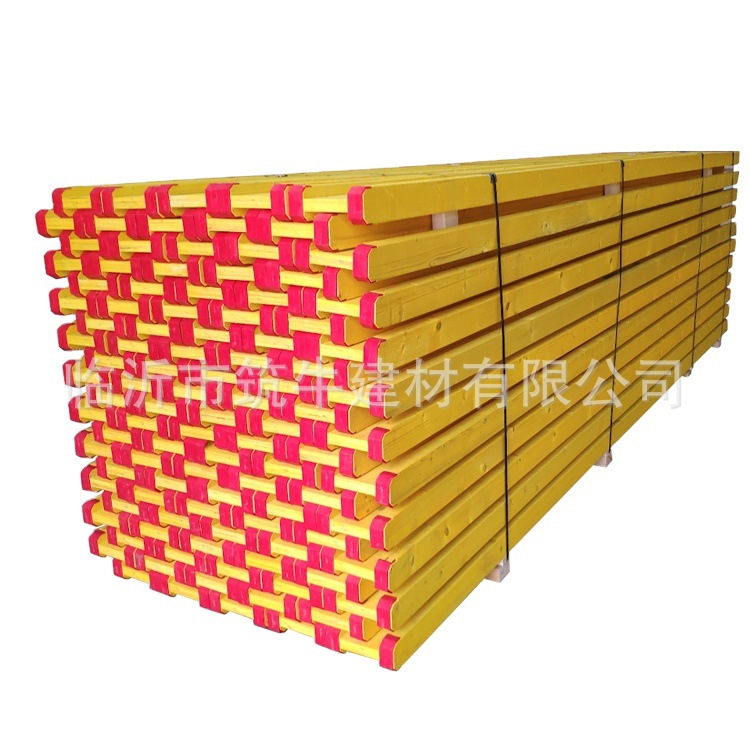Get cost-effective formwork solutions today!

Wooden H20 Beam Timber Slab
High-quality H20 beams plywood for formwork
$7.00$6.50
Introduction
The H20 wooden beam stands as a cornerstone in modern construction, offering an optimal blend of strength, versatility, and sustainability. Engineered to meet rigorous industry standards, this innovative beam design has revolutionized formwork systems, roofing structures, and various load-bearing applications. Its distinctive "I" cross-section efficiently distributes loads, maximizing strength while minimizing material usage. This document provides a comprehensive overview of the H20 wooden I-beam, exploring its specifications, applications, advantages, and technical parameters.
Product Specifications
Design and Structure
The H20 wooden I-beam features a unique I-shaped cross-section composed of three primary components:
- Flanges: Constructed from high-quality softwood, typically spruce or pine, with a thickness of 28mm. These provide excellent resistance to bending and shear forces.
- Web: A central plywood layer, 11mm thick, made from Douglas Fir or similar durable timber. The web connects the flanges, enhancing stability and load distribution.
- Adhesive Bond: The components are joined using waterproof phenolic resin glue, ensuring a robust and durable bond that withstands demanding construction environments.
Dimensions
- Standard Lengths: Available in lengths from 2.4m to 6m, with custom lengths available upon request.
- Cross-Section: The beam measures 200mm in height, with a flange width of 100mm, providing a consistent and reliable profile for formwork systems.
Technical Parameters
- Moisture Content: Maintained between 12% and 18%, ensuring dimensional stability and resistance to warping.
- Density: Flanges: 480-520 kg/m³; Web: 580-620 kg/m³
- Load Capacity: Capable of supporting heavy loads, with a design shear strength of 25 N/mm² and a bending strength of 28 N/mm².
- Fire Resistance: Treated with fire-retardant chemicals to achieve a Class C fire rating (EN 13501-1), enhancing safety in construction environments.
Key Features and Advantages
3.1 High Strength-to-Weight Ratio
The I-beam design optimizes material distribution, providing exceptional strength while remaining lightweight. This reduces handling costs and simplifies installation, making it ideal for large-scale projects.
3.2 Reusability and Durability
Constructed from premium-grade timber and reinforced with waterproof adhesives, H20 beams can be reused up to 50 times with proper maintenance. This durability significantly reduces material waste and lifecycle costs.
3.3 Versatility
Suitable for a wide range of applications, including:
- Formwork systems for concrete slabs, columns, and walls
- Roof structures and floor joists
- Bridge construction and temporary supports
- Industrial and commercial building projects
3.4 Sustainability
Manufactured from FSC®-certified timber, the H20 beam supports sustainable forestry practices. Its long service life and reusability further contribute to eco-friendly construction methods.
3.5 Easy Installation
The standardized dimensions and lightweight design facilitate quick and efficient installation. The beams can be easily cut, drilled, and fastened using conventional tools, reducing labor time and costs.
4. Applications
##### 4.1 Formwork Systems
H20 beams are widely used in formwork due to their uniform dimensions and high load capacity. They provide reliable support for concrete structures, ensuring precise shaping and alignment during the curing process.
##### 4.2 Roofing and Flooring
As roof joists or floor beams, H20 wooden I-beams offer stable support for roofing materials and floor finishes. Their lightweight nature reduces the structural load on foundations, making them suitable for a variety of building types.
##### 4.3 Temporary Structures
In construction sites, H20 beams are employed to create temporary supports, scaffolding, and access platforms. Their durability and load-bearing capacity ensure safe working environments during building and renovation projects.
##### 4.4 Bridge Construction
The high strength and versatility of H20 beams make them ideal for bridge deck formwork and temporary bridge structures. They can be easily adapted to various span lengths and load requirements.
#### 5. Quality Control and Certifications
Our H20 wooden I-beams undergo rigorous quality control measures to ensure compliance with international standards:
- EN 14080: Conforms to European standards for structural timber elements
- FSC® Certification: Ensures sustainable sourcing of raw materials
- CE Marking: Indicates compliance with European construction product regulations
- ISO 9001: Manufactured under a certified quality management system
Each beam is marked with relevant specifications and batch numbers for traceability and quality assurance.
#### 6. Maintenance and Storage
To maximize the lifespan of H20 wooden I-beams:
- Cleaning: After use, remove concrete residues and debris using a stiff brush or low-pressure water jet.
- Storage: Store beams in a dry, well-ventilated area, protected from direct sunlight and moisture. Stack them on level supports to prevent warping.
- Inspection: Regularly check for signs of damage, such as cracks or delamination. Damaged beams should be repaired or replaced promptly.
#### 7. Environmental Impact
The H20 wooden I-beam aligns with green building practices:
- Renewable Resource: Timber is a renewable and biodegradable material.
- Energy Efficiency: Requires less energy to produce compared to steel or concrete beams.
- Carbon Sequestration: Timber stores carbon dioxide, reducing the carbon footprint of construction projects.
#### 8. Conclusion
The H20 wooden I-beam represents a smart choice for modern construction professionals seeking a balance of performance, sustainability, and cost-effectiveness. With its exceptional strength, versatility, and eco-friendly credentials, it is an indispensable component in a wide range of building applications. Whether for formwork, roofing, or temporary structures, the H20 beam delivers reliable performance that meets the demands of today's construction industry.
For more information or to request a quote, please contact our technical sales team. We are committed to providing tailored solutions and expert support for your construction needs.
Got a specific enquiry about Zhuniu Formwork?
Why not call our team on +86 180 5453 6350 (Whatsapp&Wechat)
FAQ
1. What's the best formwork material for my project?
Answer: It depends on scale and reuse needs:Wooden: Ideal for small projects (5-10 reuses), low cost but high waste.
Steel: Heavy-duty for high-rises (50+ reuses), but costly upfront.
Plastic: Eco-friendly, lightweight (30-50% faster installation), pays off after 5-8 uses.
Fiberglass: For complex shapes (curves, arches) in corrosive environments.
2. How many times can plastic formwork be reused?
Answer: Our high-strength plastic formwork lasts 50-60 cycles with proper maintenance (e.g., cleaning after each use, UV protection during storage). This reduces material costs by 40% compared to wooden templates.
3. Can formwork be customized for unique concrete shapes?
Answer: Yes. Fiberglass and plastic formwork can be molded into:Curved columns for architectural designs
Tapered bridge piers
Decorative concrete textures
3D printing and CNC machining enable precision customizations.
4. How does formwork affect concrete surface quality?
Answer: High-quality formwork (e.g., steel or plastic with smooth finishes) ensures:Smooth surfaces: Reduces need for plastering (saves $1-2/㎡).
Uniform dimensions: Tolerance within ±2mm, meeting structural standards.
Fewer defects: Properly sealed formwork prevents air bubbles and honeycombing.
5. Is plastic formwork environmentally friendly?
Answer: Yes, compared to traditional materials:Recyclable: 100% of our plastic formwork can be recycled into new panels.
Timber-saving: Replaces 80% of wooden formwork use.
Low carbon: Production emits 35% less CO₂ than steel formwork.
Holds ISO 14001 environmental certification.
6. How to calculate formwork cost-effectiveness?
Example Calculation:Wooden formwork: $5/sq.m, reusable 8 times → $0.63/sq.m per use.
Plastic formwork: $20/sq.m, reusable 50 times → $0.40/sq.m per use.
Break-even point: After 5 uses, plastic becomes cheaper.
7. What safety features should formwork have?
Key Features:Load-bearing certification: Meets ASTM E136 fire resistance standards.
Anti-slip surfaces: For worker safety during installation.
Corrosion-resistant ties: Stainless steel for coastal projects.
Edge protection: Rubberized corners to prevent impact damage.
8. How long does formwork delivery take?
Answer:Standard panels: 7-10 business days (in-stock items).
Custom orders: 3-4 weeks (includes design and manufacturing).
Expedited shipping (2-3 days) available for urgent projects at additional cost.
9. What maintenance is required for steel formwork?
Maintenance Tips:Clean concrete residue with pressure washers.
Apply anti-rust paint every 6 months.
Inspect welds for cracks before each use.
Store in dry areas to prevent moisture damage.
10. Do you offer on-site installation training?
Answer: Yes, all clients receive:Free training sessions: 2-day on-site workshop for installation teams.
Video tutorials: Step-by-step guides for modular systems.
Technical hotline: 24/7 support for emergency queries.
Why choose us
1. Superior Durability & Reusability
Our plastic concrete formwork is engineered with high-strength composite materials, ensuring exceptional resistance to impact, corrosion, and wear. Compared to traditional wooden or metal templates, our products can be reused up to 50+ times, significantly reducing replacement costs and material waste over the lifespan of your projects.
2. Lightweight Design for Enhanced Efficiency
Designed with lightweight properties, our formwork reduces labor intensity and installation time by 30-50%. The easy-to-handle structure allows for quick assembly and disassembly, ideal for projects with tight schedules. This efficiency translates to lower labor costs and accelerated construction timelines.
3. Environmental Sustainability
Committed to green construction, our plastic formwork is:
Recyclable: Made from eco-friendly materials that can be recycled at the end of their service life, minimizing environmental impact.
Timber-Saving: Eliminates the need for disposable wooden templates, contributing to forest conservation and sustainable building practices.
Low Carbon Footprint: Reduces energy consumption during production and transportation compared to metal alternatives.
4. Precision Engineering for Perfect Finishes
Our formwork ensures smooth, defect-free concrete surfaces with minimal need for post-processing. The high-precision molds and consistent material properties guarantee uniform dimensions, reducing rework and enhancing the aesthetic and structural quality of your projects.
5. Cost-Effective Long-Term Investment
While initial costs may seem comparable to traditional templates, the long-term savings are substantial:
Reduced Replacement Costs: Fewer replacements mean lower material expenses.
Minimal Maintenance: Resistant to water, chemicals, and UV damage, requiring little upkeep.
High Return on Investment (ROI): Proves cost-effective after just 5-8 uses, making it ideal for large-scale or repetitive projects.
Choose our plastic concrete formwork to transform your construction projects with efficiency, sustainability, and cost savings. Contact us today to discover how our solutions can elevate your next venture!
